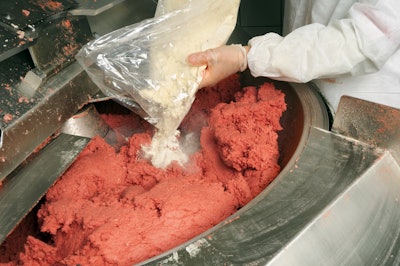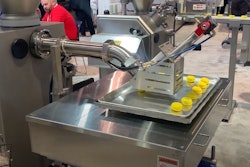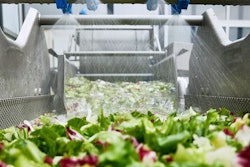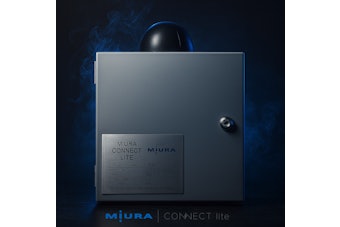
Within the world of food and beverage processing, mixing and blending occupies at least its own continent. The wide array of equipment and processes match the vast range of complex applications our industry requires.
No matter the application, consistency is the name of the game when it comes to mixing and blending, whether you are working with solid-solid, liquid-liquid, and liquid-solid processing. Achieving the desired quality, flavor, and texture in the final product relies on the seamless blending of various powders, ingredients, and liquids into base ingredients.
Factors to consider in equipment selection
The quest for precision, efficiency, and homogeneity in mixing and blending requires selecting the right equipment for the job. To do that, you will first need to take a look at the unique characteristics of your ingredients.
- Look closely at ingredients. Are you dealing with pellets, powders, flakes, granules, raw or cooked meat, fruits, vegetables, liquids, slurries, or additives? Each application demands specialized equipment tailored to handle the specifics of the ingredients in question.
- Consider potential ingredient changes. Is it likely that you will change ingredient formats in the short- or mid-term? For example, are you considering moving from a powder to a liquid for a certain ingredient? Are you looking at replacing cooked onions with onion powder, or vice-versa? Perhaps you are adding meat substitutes, which have different viscosities and properties than natural meat, and therefore impact your equipment mix on the plant floor.
- Look at how the machine is built. With the stringent hygiene standards that define the industry, stainless steel is the material of choice for most applications: It has exceptional durability, hygienic properties, and corrosion-resistant surface. Be sure to look for machines with stainless steel components that are easy to access, remove (if required), and clean.
Main types of equipment
While there are countless types of specialty blenders and mixers, the main types of equipment include these.
- Batch mixers are the workhorses of mixing and blending operations for small to medium-scale food and beverage processing where mixing is done batch by batch. Batch mixers get the job of ensuring consistent flavor and texture of products done through various processes, such as emulsifying, disintegrating, solubilizing, and homogenizing solids. Designed to blend precise quantities of ingredients, batch mixers ensure consistent flavors and textures in products such as sauces and dressings.
- Continuous mixers serve as the backbone of high-volume food and beverage production. These industrial giants excel in seamlessly blending ingredients in a continuous flow, guaranteeing productivity. The concept of continuous mixing involves consistently measuring ingredients as they flow directly into the mixing chamber, resulting in a non-stop flow of blended products emerging from the mixer. In beverage processing, continuous blenders are indispensable in maintaining flavor profiles and ingredient uniformity, making them crucial for the production of juices, soft drinks, and alcoholic beverages.
- High-shear mixers use high-speed rotors and stators with high-grade impellers to blend different liquids and solids that are normally immiscible into a smooth, uniform emulsion. High-shear mixers help food and beverage brands speed up processes such as hydrating powder or mixing powder into a liquid. For example, high-shear mixers are instrumental in the production of mixing egg yolks and sugar into a smooth paste for certain baking applications.
- Paddle mixers, fitted with rotating blades, facilitate the gentle and even blending of materials within a tank or trough. They are often used in food processing applications for mixing dry or powdery ingredients without compromising product integrity.
- Homogenizers are essential for breaking down and dispersing particles, such as fat globules in milk, to yield a stable and consistent mixture. Homogenizers force fluids through a narrow orifice under high pressure making them indispensable for creating products like mayonnaise and various dairy products.
- Planetary mixers take their name from the motion of the agitator or mixing head that rotates on an offset shaft that resembles planets orbiting in the solar system. Using multiple blades, planetary mixers are used for the thorough mixing of highly viscous materials, such as dough, creams, and pastes.
- Emulsifiers are specialized mixers employed to create and stabilize emulsions, ensuring that immiscible liquids, such as oil and water, form a stable, fine suspension. These devices are crucial in the food industry for producing items like salad dressings and mayonnaise.
- Agitators and portable mixers are mixing instruments, typically equipped with impellers, designed to generate fluid motion within tanks or vessels. An operator will drop an agitator into a tank to blend, suspend solids, and maintain uniform temperature in large containers.
- Ribbon mixers have a U-shaped trough with a helical ribbon agitator within, making it well-suited for gently and evenly blending dry or powdery ingredients. This makes it a critical piece of equipment in baking and confectionery applications.
- Inline mixers blend products as they flow through tubes rather than in tanks, kettles, or drums in applications where vigorous mixing is required. Whereas static inline mixers blend and harmonize fluids as they flow through specifically designed pipes or tubes, devoid of moving parts, dynamic inline mixers employ moving components like impellers or rotors to blend and homogenize fluids as they move through the pipe or tube.




















